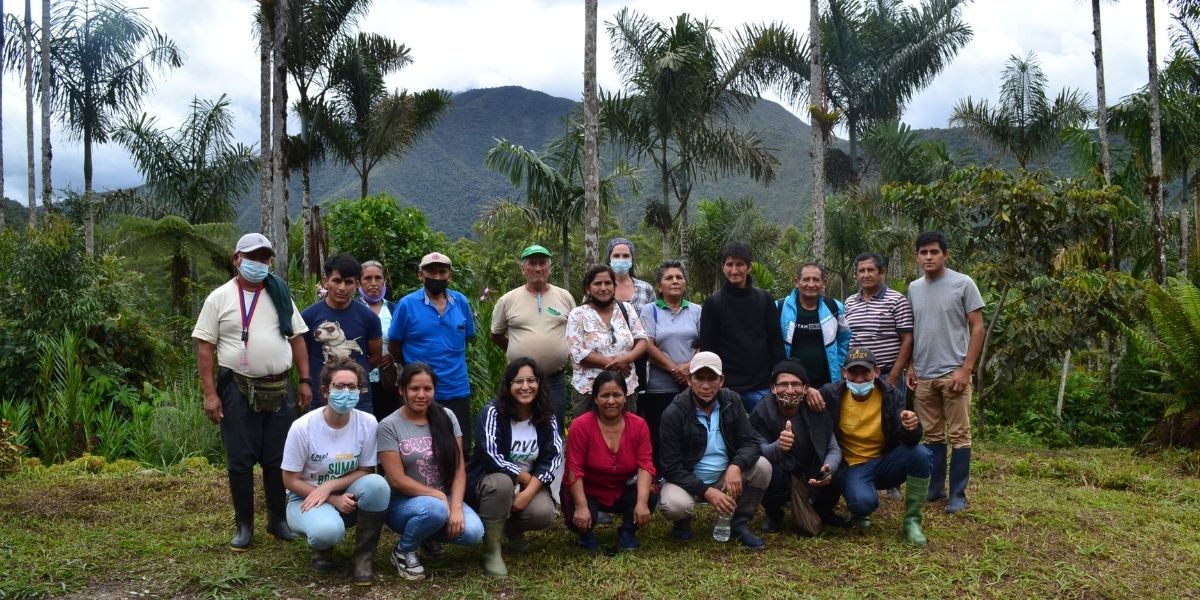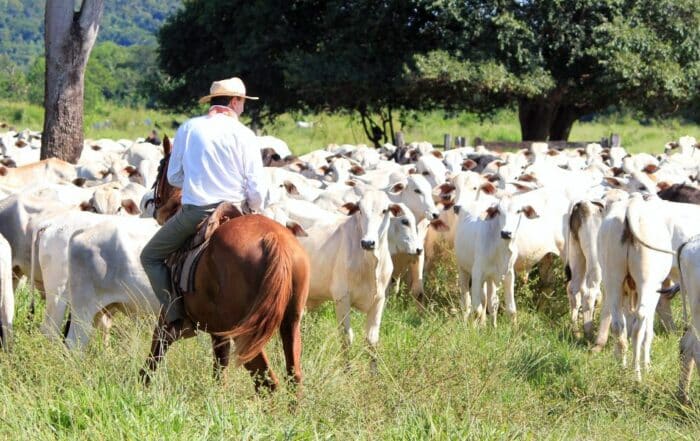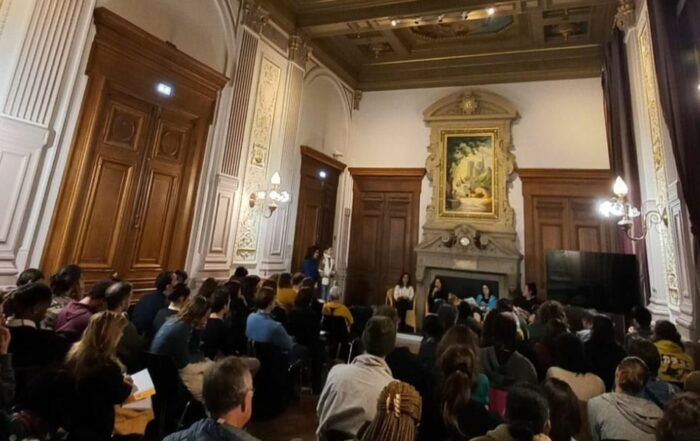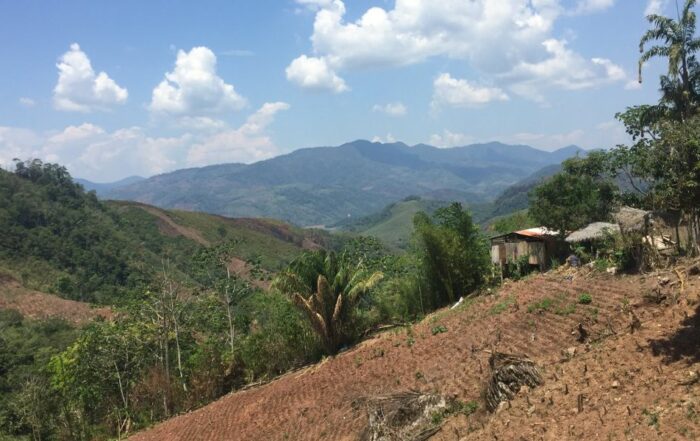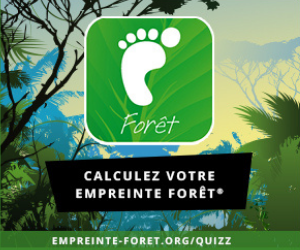In January 2022, 15 farmers from the project in Pichanaki participated in a course on “Private and voluntary conservation initiatives”. The objective of this activity was to learn about a form of forest conservation, developed through individual initiatives, in private areas: private conservation areas (PCA).
We visited 3 of the 10 conservation initiatives that are part of the Oxapampa network of conservation areas (RIACO), which has the objectives of:
The three conservation initiatives we visited were:
![[AGROFOCAFE]bio construcción_enero2022_M. correia](https://envol-vert.org/wp-content/uploads/2022/02/AGROFOCAFEbio-construccion_enero2022_M.-correia-533x400.jpg)
Tierra de Bosques
Run by Lucía and Marcos, who have 46 hectares, of which 30 correspond to forest. They take advantage of the resources of the forest while protecting and rehabilitating it through techniques such as “regenerative agriculture” and “bio-construction“. They use natural elements such as clay, wood, wood chips and other organic waste. for the construction of houses. This type of construction reduces the impact on the natural landscape. During the visit, Marcos reminded us of the importance of maintaining forest areas on the peaks to allow water to be captured from fog and rain, and thus feed the water sources downstream in the lower areas.
Bosques de Churumazú
Eduardo Jackson, owner of this ACP, showed us the wonderful so-called mountain forest, 14 hectares are protected here. This area is usually visited by specialists and enthusiasts of bird watching and identification. 176 species of birds have been identified in this area, 6 of which are endemic. Eduardo reminded us of the importance of birds in the conservation and the recovery of forests and agriculture, thanks to their pollination and seed dispersal functions. He shared with us his experience in restoring areas degraded by overgrazing by cattle, with native species from nearby forests. Through his ACP, Eduardo contributes to landscape connectivity and habitat for several wildlife species, including the iconic spectacled bear. His forest also provides habitat for endangered tree species, such as the ‘nogal negro’ (Juglan neotropica), which is well known to the participants.
![[AGROFOCAFE]contemplando el bosque_enero2022_M. Correia](https://envol-vert.org/wp-content/uploads/2022/02/AGROFOCAFEcontemplando-el-bosque_enero2022_M.-Correia-533x400.jpg)
![[AGROFOCAFE]Acp el palmeral_enero2022_M. correia](https://envol-vert.org/wp-content/uploads/2022/02/AGROFOCAFEAcp-el-palmeral_enero2022_M.-correia-533x400.jpg)
El Palmeral
It’s an initiative led by Patricia Reyna, an educator and psychotherapist by profession, and a conservationist at heart. Patricia protects 10 hectares of forest, helping to protect biodiversity and endangered species such as the Basanco palm (Dictyocaryum lamarckianum), the tree fern and 6 endemic birds, while bringing people closer to nature and improving their physical and emotional health, through a technique known as ‘forest bathing‘. A service that she offers to her visitors and that allows her to generate economic income. Patricia is an intelligent woman and a conservation warrior, like many of the farmers we work with at Envol Vert.
In addition to individual initiatives, the three PCAs visited are developing a joint project, through their network, where people can sponsor or adopt standing (or planted) trees for conservation, generating income for the network. A new way to finance conservation.
The participants also shared with Eduardo, Marcos and Patricia some of the knowledge they have gained in the field of agroforestry and conservation. In conclusion, it was a day rich in learning, knowledge exchange and fruitful experiences combining economic resources, sustainable agriculture and conservation of the forest and its biodiversity.
In January 2022, 15 farmers from the project in Pichanaki participated in a course on “Private and voluntary conservation initiatives”. The objective of this activity was to learn about a form of forest conservation, developed through individual initiatives, in private areas: private conservation areas (PCA).
We visited 3 of the 10 conservation initiatives that are part of the Oxapampa network of conservation areas (RIACO), which has the objectives of:
The three conservation initiatives we visited were:
![[AGROFOCAFE]bio construcción_enero2022_M. correia](https://envol-vert.org/wp-content/uploads/2022/02/AGROFOCAFEbio-construccion_enero2022_M.-correia-533x400.jpg)
Tierra de Bosques
Run by Lucía and Marcos, who have 46 hectares, of which 30 correspond to forest. They take advantage of the resources of the forest while protecting and rehabilitating it through techniques such as “regenerative agriculture” and “bio-construction“. They use natural elements such as clay, wood, wood chips and other organic waste. for the construction of houses. This type of construction reduces the impact on the natural landscape. During the visit, Marcos reminded us of the importance of maintaining forest areas on the peaks to allow water to be captured from fog and rain, and thus feed the water sources downstream in the lower areas.
Bosques de Churumazú
Eduardo Jackson, owner of this ACP, showed us the wonderful so-called mountain forest, 14 hectares are protected here. This area is usually visited by specialists and enthusiasts of bird watching and identification. 176 species of birds have been identified in this area, 6 of which are endemic. Eduardo reminded us of the importance of birds in the conservation and the recovery of forests and agriculture, thanks to their pollination and seed dispersal functions. He shared with us his experience in restoring areas degraded by overgrazing by cattle, with native species from nearby forests. Through his ACP, Eduardo contributes to landscape connectivity and habitat for several wildlife species, including the iconic spectacled bear. His forest also provides habitat for endangered tree species, such as the ‘nogal negro’ (Juglan neotropica), which is well known to the participants.
![[AGROFOCAFE]contemplando el bosque_enero2022_M. Correia](https://envol-vert.org/wp-content/uploads/2022/02/AGROFOCAFEcontemplando-el-bosque_enero2022_M.-Correia-533x400.jpg)
![[AGROFOCAFE]Acp el palmeral_enero2022_M. correia](https://envol-vert.org/wp-content/uploads/2022/02/AGROFOCAFEAcp-el-palmeral_enero2022_M.-correia-533x400.jpg)
El Palmeral
It’s an initiative led by Patricia Reyna, an educator and psychotherapist by profession, and a conservationist at heart. Patricia protects 10 hectares of forest, helping to protect biodiversity and endangered species such as the Basanco palm (Dictyocaryum lamarckianum), the tree fern and 6 endemic birds, while bringing people closer to nature and improving their physical and emotional health, through a technique known as ‘forest bathing‘. A service that she offers to her visitors and that allows her to generate economic income. Patricia is an intelligent woman and a conservation warrior, like many of the farmers we work with at Envol Vert.
In addition to individual initiatives, the three PCAs visited are developing a joint project, through their network, where people can sponsor or adopt standing (or planted) trees for conservation, generating income for the network. A new way to finance conservation.
The participants also shared with Eduardo, Marcos and Patricia some of the knowledge they have gained in the field of agroforestry and conservation. In conclusion, it was a day rich in learning, knowledge exchange and fruitful experiences combining economic resources, sustainable agriculture and conservation of the forest and its biodiversity.

